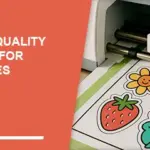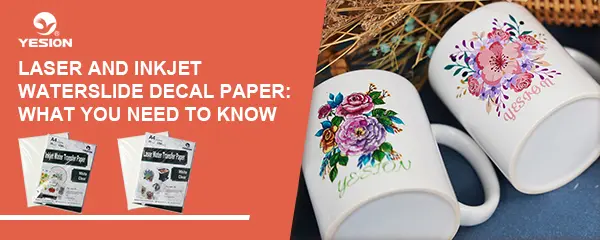
Weeding Tools For Vinyl: Which Should You Buy?
2025-06-06
The Best High Quality Sticker Paper for Cricut Machines
2025-06-20Choosing the right waterslide decal paper can make or break your DIY project or product customization workflow. While both laser and inkjet waterslide decal papers are used to transfer images onto various surfaces—such as ceramics, glass, metal, and plastic—the type of printer you use plays a critical role in determining which paper delivers the best results. In this detailed guide, we break down the core differences, advantages, disadvantages, and use cases to help you select the perfect waterslide paper for your creative or business needs.
What is Waterslide Decal Paper?
Waterslide decal paper is a printable transfer paper that allows you to move a design or image onto a non-porous surface using water. It comes in two major types based on printer compatibility:
- Inkjet waterslide decal paper
- Laser waterslide decal paper
Each type has specific coating and chemical properties tailored to the printer’s ink or toner technology.
Core Differences Between Laser and Inkjet Waterslide Papers
1. Printing Technology Compatibility
- Inkjet Waterslide Paper is specially coated to absorb water-based inkjet inks. It requires sealing before application to prevent smearing.
- Laser Waterslide Paper is heat-resistant and designed to handle toner fusing from a laser printer, requiring no sealing before use.
Verdict:
If you own a laser printer, use laser decal paper. Inkjet printers require inkjet-specific paper.
2. Image Durability & Sharpness
- Laser Waterslide Paper produces sharper, crisper images with excellent colorfastness. The toner adheres well to the paper and resists bleeding.
- Inkjet Waterslide Paper offers vibrant color but may blur if not sealed correctly. It also tends to fade faster without protection.
Verdict:
Laser decals are more durable and better for detailed, high-contrast graphics.
3. Sealing Requirements
- Inkjet waterslide paper must be sealed with clear acrylic spray (usually 2–3 coats) to prevent ink from dissolving during soaking.
- Laser waterslide paper requires no sealing, making the process quicker and cleaner.
Verdict:
Laser paper is more efficient and mess-free for high-volume or time-sensitive production.
4. Surface Compatibility
Both types can be applied to:
- Glass
- Ceramic
- Plastic
- Metal
- Wood
However, laser paper performs better on heat-resistant surfaces due to its toner-based composition, while inkjet paper may be preferred for craft items where image vibrancy is a priority.
5. Cost and Availability
- Inkjet decal paper is often slightly more affordable and widely available for casual DIY crafters.
- Laser decal paper is less common, often considered a premium product, and may cost more due to its higher-quality finish.
Verdict:
If you’re producing for commercial resale or professional use, the cost of laser paper is justified by quality and speed.
Comparison: Which One is Right for You?
Use Inkjet Waterslide Decal Paper if you:
- Are working on personal crafts, gifts, or one-off projects
- Own a home inkjet printer
- Prefer vibrant, colorful images
- Don’t mind extra sealing time
Use Laser Waterslide Decal Paper if you:
- Need to save time on sealing and drying
- Work in a commercial or production setting
- Value durability, precision, and professional-grade quality
- Have access to a laser printer
Step-by-Step Application: Inkjet vs Laser
| Step | Inkjet Waterslide | Laser Waterslide |
|---|---|---|
| Print Design | Inkjet Printer | Laser Printer |
| Seal Design (3x) | ✅ Required | ❌ Not Needed |
| Cut Design | ✂️ Required | ✂️ Required |
| Soak in Water | 30–60 sec | 30–60 sec |
| Slide onto Surface | ✅ | ✅ |
| Let Dry & Optional Topcoat | ✅ Recommended | ✅ Recommended |
Pros and Cons Summary
Inkjet Waterslide Paper
Pros:
- Affordable
- Vibrant color prints
- Easy to find
Cons:
- Needs sealing
- Prone to smearing
- Less durable
Laser Waterslide Paper
Pros:
- No sealing required
- Crisp image resolution
- Fast application process
- Better for mass production
Cons:
- Requires laser printer
- Higher upfront cost
- Slightly more rigid to apply
Best Practices for Both Types
- Use high-resolution images (300+ dpi)
- Clean the surface thoroughly before applying
- Smooth out air bubbles using a soft cloth or scraper
- Let your decal dry fully (24–48 hours) before handling
- For extra durability, apply a clear topcoat
Top Recommendation
Yesion offers a full range of both inkjet and laser-compatible waterslide papers that meet high-quality standards. Whether you’re customizing a coffee mug, creating candle labels, or decorating ceramic tiles, Yesion’s adhesion strength, print clarity, and ease of use make it a trusted choice for beginners and professionals alike.
Conclusion: Which Should You Choose?
Both laser and inkjet waterslide decal papers serve their purpose well. Your decision depends on your equipment, project volume, and required finish. For quick, professional, and durable applications, laser waterslide paper is the clear winner. For budget-friendly, vibrant customizations, inkjet waterslide paper still holds strong appeal.
Start with the right material, follow best practices, and your DIY creations will shine with precision and personality.
Related:
Best Waterslide Decal Paper for Inkjet Printers
Choosing the Perfect Waterslide Decal Paper
Waterslide Decal Paper: A Comprehensive Guide for Crafters and Hobbyists
How to Print Decals on Waterslide Decal Paper: A Simple Guide for Kids

